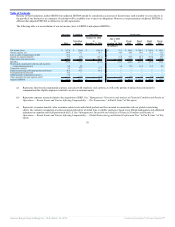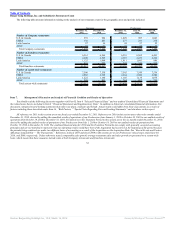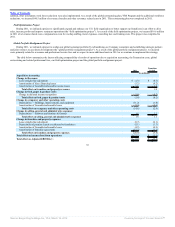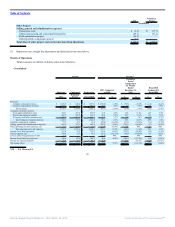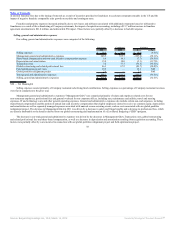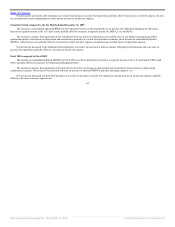Burger King 2011 Annual Report Download - page 41
Download and view the complete annual report
Please find page 41 of the 2011 Burger King annual report below. You can navigate through the pages in the report by either clicking on the pages listed below, or by using the keyword search tool below to find specific information within the annual report.
Table of Contents
CRM % decreased due to sales deleverage on our fixed payroll and employee benefits and occupancy and other operating costs driven by negative
Company comparable sales growth and the impact of acquisition accounting. These factors were partially offset by improvements in variable labor controls and
scheduling in our U.S. restaurants, improved labor efficiencies in APAC and the U.K, the benefits realized from strategic pricing initiatives in the U.S. and
Canada, a non-recurring $4.7 million favorable adjustment to our self-insurance reserve in the U.S. and Canada and changes in product mix in LAC.
Franchise and Property
The increase in franchise and property revenues was driven by royalties derived from franchise NRG, a higher effective royalty rate in EMEA and the
impact of acquisition accounting adjustments. These factors were partially offset by the impact of negative franchise comparable sales growth on royalties and
contingent rents, unfavorable FX impact, a reduction in initial franchise fees and the net effect of changes to our portfolio of properties leased to franchisees.
Franchise and property expenses increased primarily due to rent expense associated with the net refranchising of 82 Company restaurants and franchise
NRG, an increase in bad debt expense and the impact of acquisition accounting, including a $3.1 million increase in franchise agreement amortization to $6.3
million. These factors were partially offset by favorable FX impact in EMEA.
Selling, general and administrative expenses
Our selling, general and administrative expenses were comprised of the following:
Combined Predecessor Variance
Transition
Period
For the Six
Months Ended
December 31,
2009 $ %
Selling expenses $ 42.0 $ 47.1 $ (5.1) (10.8)%
Management general and administrative expenses 182.2 188.9 (6.7) (3.5)%
Share-based compensation and non-cash incentive compensation
expense 5.8 8.7 (2.9) (33.3)%
Depreciation and amortization 8.2 9.3 (1.1) (11.8)%
Transaction costs 77.7 — 77.7 0.0%
Global restructuring and related professional fees 67.2 — 67.2 0.0%
Total general and administrative expenses 341.1 206.9 134.2 64.9%
Selling, general and administrative expenses $ 383.1 $ 254.0 $129.1 50.8%
Selling expenses decreased due to the net refranchising of Company restaurants and a decrease in discretionary local marketing expenditures partially
offset by favorable FX impact.
The decrease in Management G&A was driven by a 19% decrease in travel and meeting costs and a 10% decrease in office operating expenses, partially
offset by an increase in a sales tax reserve.
The increase in our total general and administrative expenses was primarily due to transaction costs and global restructuring and related professional fees.
These factors were partially offset by a decrease in Management G&A.
40
Source: Burger King Holdings Inc, 10-K, March 14, 2012 Powered by Morningstar® Document Research℠


